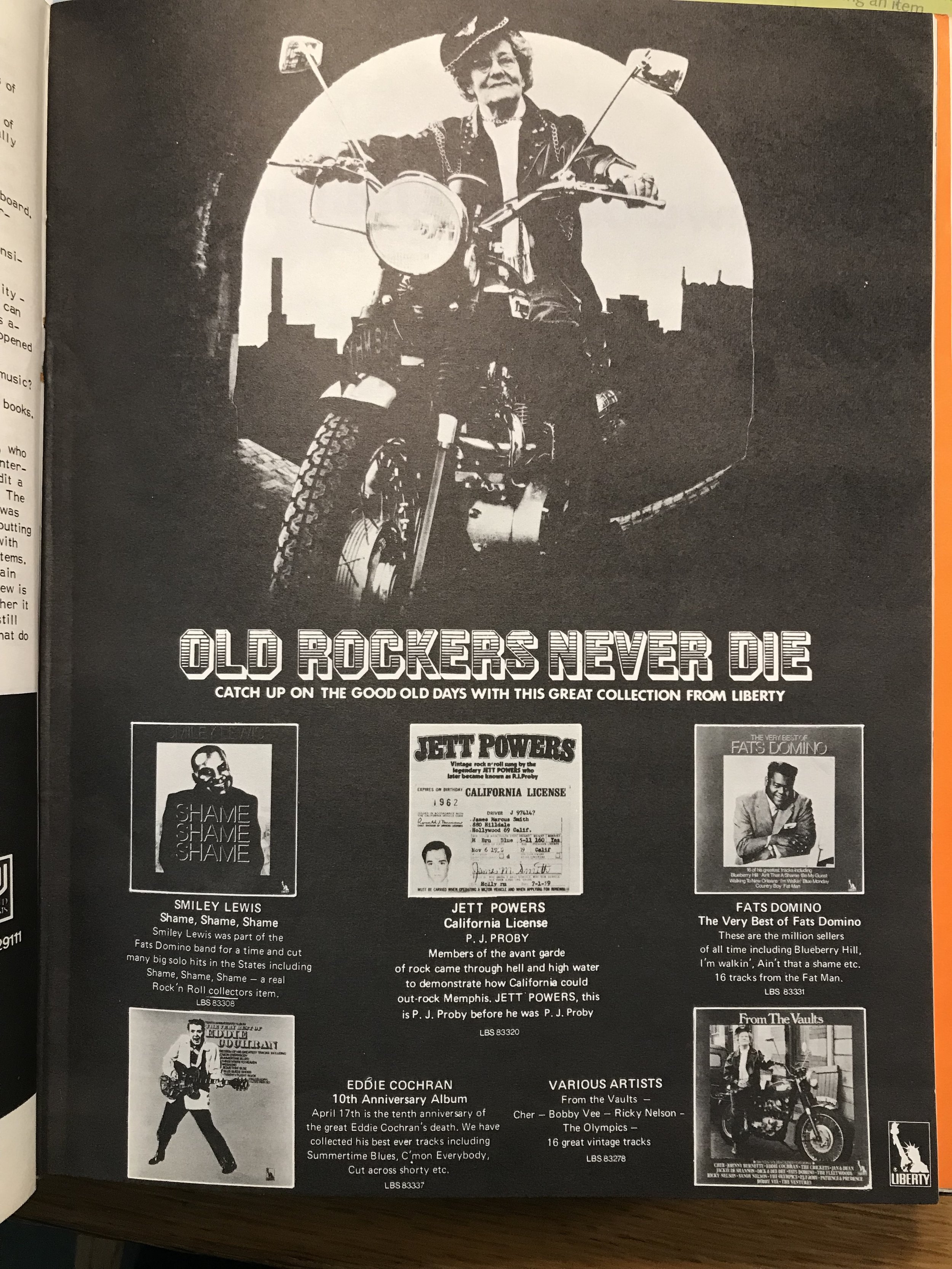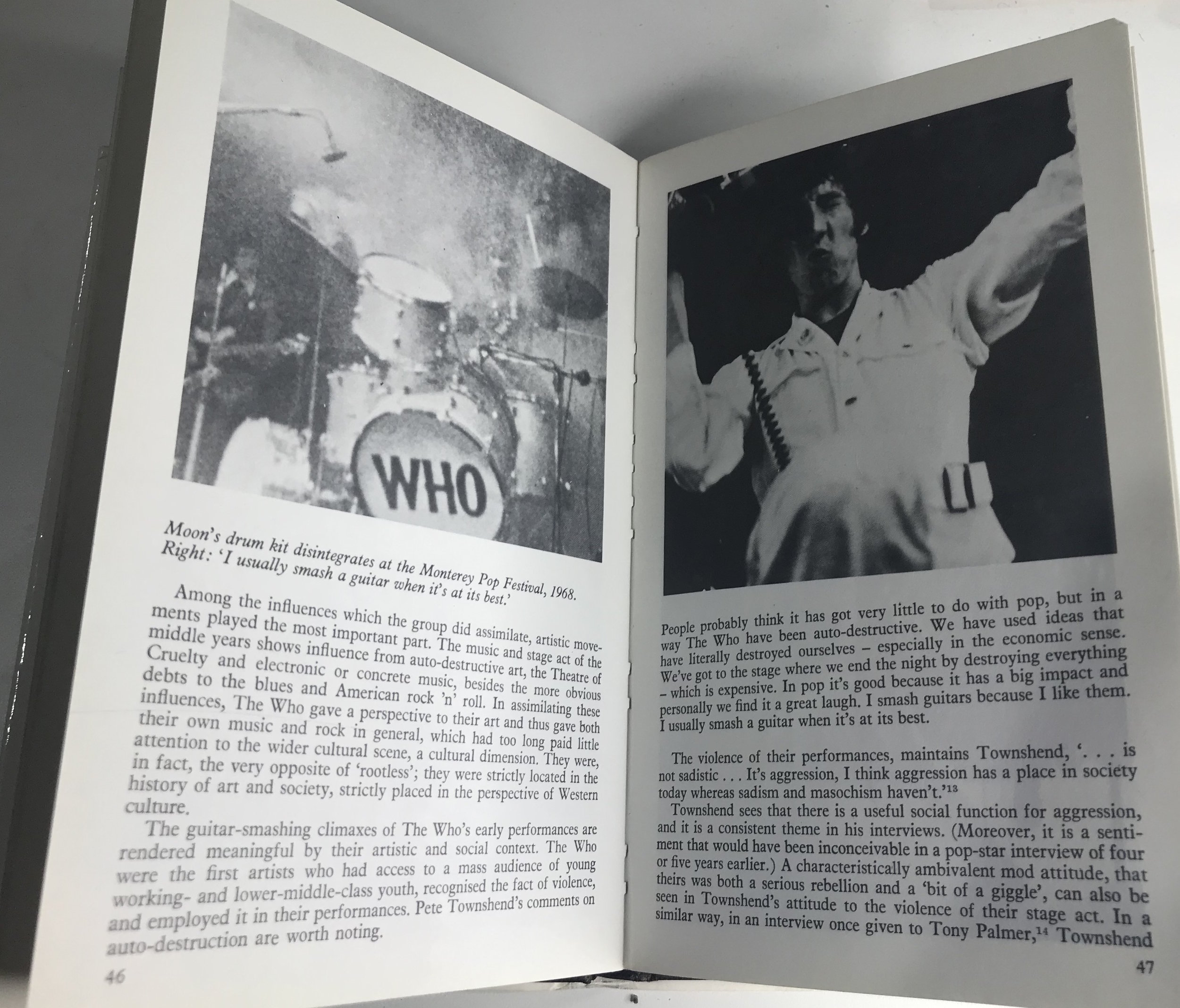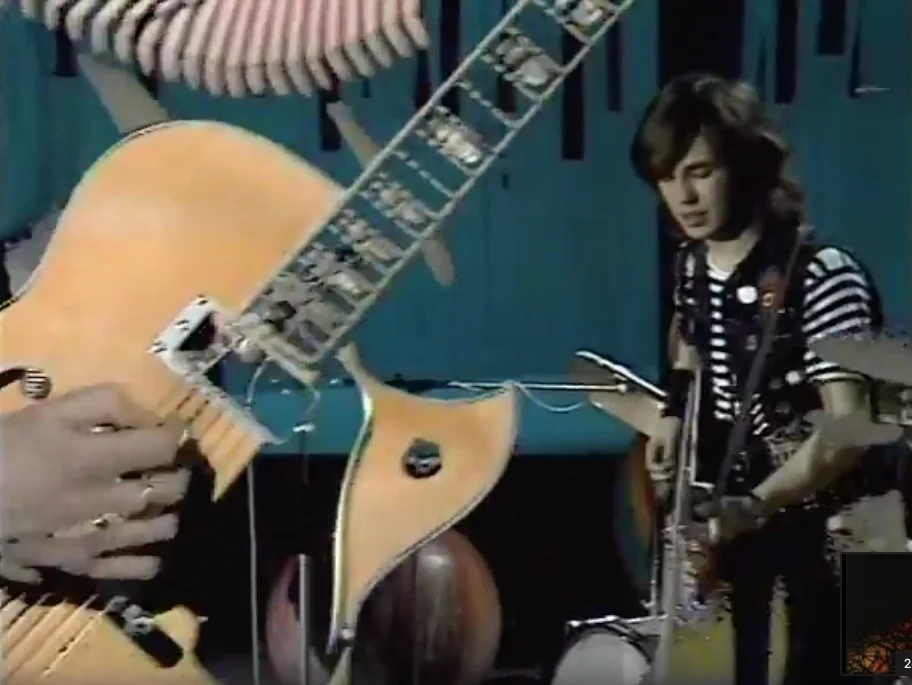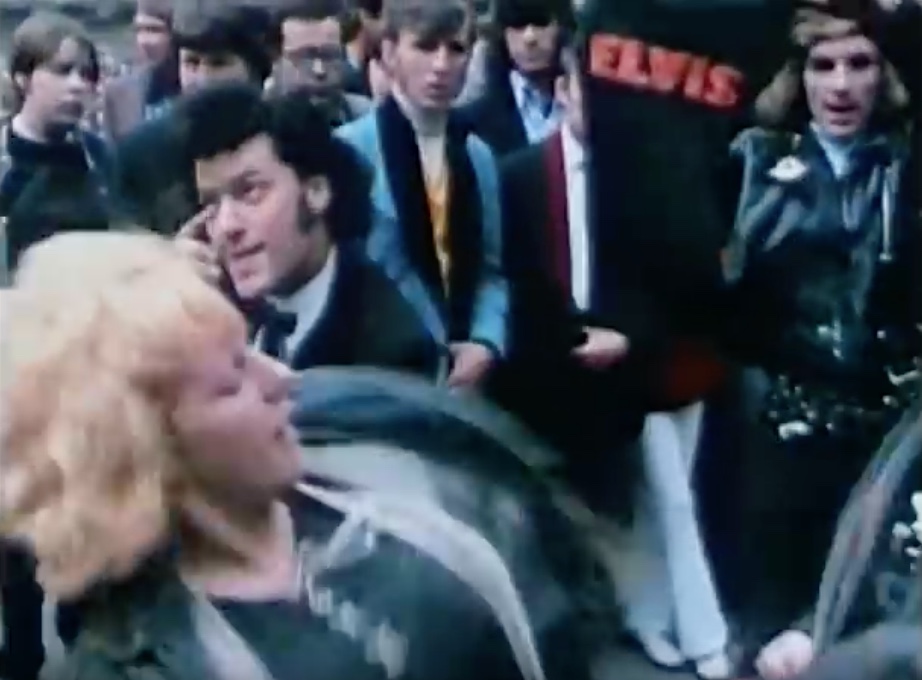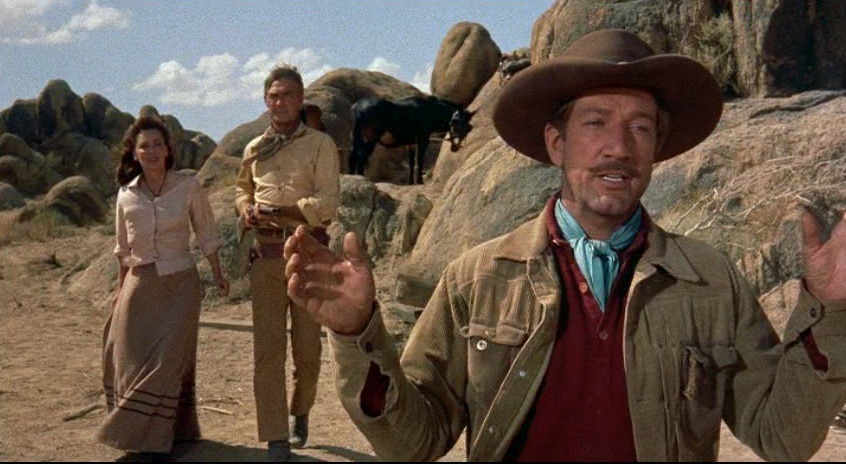The first three volumes of Chess nostalgia given a two page spread in the November 1973 edition of Let It Rock. Like so much of the rock ’n’ roll revivalism imagery it used a Philip Castle styled airbrushed update on Pop art: 50s iconography filtered through 60s Pop to get to that perfect expression of the early-mid-1970s art rock.
Eddie Cochran 'Singin' To My Baby' Liberty 1972
One of the many UA repackages of Cochran’s catalogue, nothing special here, but the cover is a terrific record of greaser culture . . .
'The Golden Years of Rock 'n' Roll' - 6 disc set (1975)
Was this the final 1970s compilation by Alan Warner of golden oldies from the UA, Liberty and Imperial catalogues? This was billed as a World Records release, part of the EMI group, and probably sold through mail order like a Reader’s Digest set. 102 tracks are played out in chronological order from 1948 to 1964. Another MONO release.
Clive Richardson from Shout magazine provided the notes, design by anonymous . . . you can tell.
'Rock 'n' Roll Jamboree' 4 disc boxed set UA (1974)
UMO 4000 . . . at some point in 1974 UA repacked the first 2 volumes of the Many Sides of Rock ’n’ Roll and put them in a box with a booklet that reproduced the notes from inside the gatefold sleeves. The one significant difference was that these four discs are all in MONO . . . all three volumes and the four single disc sets were all ‘electronically enhanced to simulate a stereo effect.’ The mono purists were out there pushing their agenda . . . and Alan Warner and UA were now working their side of the road.
16 Golden Oldies, From the Vaults - volumes 1-3
Each volume offers ‘16 Golden Oldies’ from the usual catalogue culprits, the first two are on the Liberty label and the final one on UA. All put together by the estimable Alan Warner
LBS 83278 . . . Photography Mike Hasted, motorcycle courtesy of Raymond Way Motors Ltd, Kilburn. Rings and chains courtesy of Adrien Mann
LBS 83377 . . . cover photograph by Red Saunders. This one goes full topless and seems to have escaped from the store room of Tommy Roberts’ emporium, Mr. Freedom. It makes no sense in this context whatsoever, but I think it is great.
UAS 29153 . . . design is credited to ‘Painted Lady, London.’ I can’t make out signature beneath the car.
Zigzag magazine #12 (May 1970) – I think I need that Jett Powers collection . . .
Zigzag #20 (1972)
Rock 'n' Roll Is Here To Stay UA 1973
UAS29336 is the catalogue number and the fourth volume, I think, of Alan Warner compilations. The usual United Artist/Liberty/Imperial contractees are all here along side a licensed Jerry Lee Lewis Sun cut, but the real interest is with the ‘70s sleaze: the Bardot lookalike model and the Ted in full drape mode, cutthroat razor and cheroot. And the chopper, the ultimate period prop . . . cliche on cliche . . . Nice.
Photography by Bryce Attwell
The Many Sides of Rock'n' Roll Vols 1-3
The late 60s - early 70s rock ’n’ roll revival bought not only old rockers back to British stages and new bands to beat on the traps of the first generations song books, but it also bought a small flood of reissues. Some of the best of these were curated on the United Artists label under the guidance of Alan Warner.
The three double album volumes were released in 1973-74 with each side themed, ‘instrumentals, ‘rock’n’ roll stars’, ‘teen ballads’, ‘groups’ and so on. Each came with a four page photograph styled album of images of the groups and singers and some cursory notes .
UA had access to the catalogues of Eddie Cochran, Fats Domino, Smiley Lewis, Johnny Burnette, The Ventures, and Bobby Vee and they mined these tape vaults mercilessly.
Pierre Tubbs was the art director across the series and he utilised a number of photographers and illustrators.
Photo session produced by Norman Seef (Los Angeles) and it is awful . . .
Illustration by Bob Cotton
Illustration by Michael Bennallack-Hart. This album pushes into the mid-1960s with The Count Five’s ‘Psychotic Reaction’ and it gives a plug to the ‘superb anthology of similar items on an album called Nuggets on Elektra.’
Gary Herman, 'The Who' (Studio Vista, 1971)
The first book to be published on the The Who, but one rarely referenced. The author had a column in Let It Rock where he wrote about technical things like microphones and PA systems. That side is lacking here, instead he uses an Eng. Lit. approach to pick apart the themes in Townshend’s songs, which is all so so. In what is essentially a long essay, the best element by far is how he works in a relatively sustained examination of the band’s synthesis of a Mod sensibility into their work and very being - a Mod’s view of life that is as much there in ‘My Generation’ as it is in ‘Sally Simpson’ or any other number from Tommy.
‘Above all, because Mods pursued the end of non-self-alienation, they also pursued collective experience. It is totally inaccurate to describe Mods as “individualists,” for they were only individualist in the sense that the whole group saw itself, and was seen, as a unit separate from the conformities of contemporary society. . . No matter how far The Who have left their original sources of inspiration behind, the jubilation and the triumph of the collective mod experience always manages to reassert itself.’
The book is also thoughtfully illustrated throughout with some brilliantly chosen images and carefully considered page design. David Goard’s otherwise unremarkable cover illustration foreshadows Quadrophenia with its rendering of Townshend’s head combining the band’s four facets.
Addendum
In the February 1975 edition of Let It Rock, Gary Herman gave the low-down on all things Who since the publication of his book in 1971. Solo albums from Daltrey and Townshend, three from Entwistle and one forthcoming from Moon, seven singles, Leeds, Next and Quadrophenia, and two compilations had followed. A lot of product . . .
In his review of Quadrophenia for Phonograph Review (December 1973), Greg Shaw noted that Gary Herman had written ‘a whole book about Mod, and when it came time to put a title on it, his choice was clear cut, he called it “The Who.”’ Which is kinda true in a way, so it is not surprising Herman is most concerned with the band’s latest studio outing in his Let It Rock overview. He was not much impressed:
But Quadrophenia doesn’t ring true as a simple Mod’s tale. It’s too overloaded with Townshend’s self-conscious and arty interpretations; it’s too much of what he thinks Mods should have felt.
Nik Cohn - if the hat fits
Nik Cohn proving the old adage a hat makes the man in a portrait by Amy Arbus that accompanied a 2011 New York Times profile here
Nik Cohn - 'Tribal Rites of the New Saturday Night' (1976)
A fascinating interview with James McMullan who provided the sharply observed illustrations that accompanied Cohn’s story is found here
London Rock 'n' Roll Show, Wembley 1972
Paul Gorman has posted a host of images and information on the show, here. Dig around a little more on his site and you’ll find much much more on the topic, especially on the Malcolm McLaren connection
Wild Angels - 'Brand New Cadillac' 1973
For this performance alone, the Wild Angels fully justify the early seventies R’n’R revival . . . Vince Taylor’s number also opens their superior Decca album Out at Last (1973), which is, with Shakin’ Stevens and the Sunsets’ Legend (1972), the best recordings the revival had to offer.
London Rock and Roll Show 1972
Looking toward the future and the MC5’s set, Wilko Johnston backs up Heinz on an excruciatingly bad cover of Cochran’s ‘C’Mon Everybody’ at the 1972 London Rock and Roll Show at Wembley.
The BFI really should release a hi-definition disc of this doc . . . band performances are uniformly horrible, all the energy and interest is in and with the audience.
Born Losers
Whatever the outlaw biker picture, whether in bikinis or not, small town girls are always a willing audience for the hoodlums’ pranks
Elmore Leonard and The Tall T (part 2)
LaBrava (1983) begins Elmore Leonard’s evermore excessive referencing of Hollywood movies and the use of narrative devices that depend on a merging of the real and the reel that had its greatest success with Get Shorty (1991). Here, a middle-aged retired Hollywood star who specialised in femme fatales replays one of her old movies . . . Robert Mitchum is endlessly referred to, but it is talk of Henry Silva who jogs another movie memory:
“I know Henry Silva was the bad guy,” LaBrava said. “I remember him because he was in a Western just about the same time and I saw it again in Independence. The Tall T, with Richard Boone and, what’s his name, Randolph Scott.”
Elmore Leonard and Valdez is Coming
Elmore Leonard’s in-jokes #1
“You’re positive,” Raylan said, “it was Bob Valdez.” …
“Before they showed,” Loretta said, “Bob phoned and said to tell my dad, ‘Valdez is coming.’ You ever hear of anything like that?”
Elmore Leonard Raylan (2012). Valdez was first published in 1970
'The Tall T' - by his bandana you will know the man
The Tall T (Budd Boetticher, 1957)
By his bandana a man will be judged …
Chink’s and Billy Jack’s flamboyant bandanas are contrasted with Pat Brennan’s (Randolph Scott) more sedate affair, but all pale next to Frank Usher’s (Richard Boone) turquoise neckerchief.
Playing on the period’s usual Freudian overloading, Chink (Henry Silva) and Billy Jack (Skip Homeier) are perfectly drawn punk psychos – fully formed killers but barely formed humans.
Boone is wearing a corduroy Wrangler 11MJ style jacket - pure 1950s – Homeier wears Levi’s under his leather chaps …
Elmore Leonard and The Tall T (part 2)
This map was produced for The Complete Western Stories of Elmore Leonard, most of the tales take place in Arizona. It got me to wondering whether the map would also double for the territory Budd Boetticher’s characters wander through …
Elmore Leonard and Stag O'Lee (part 2)
Elmore Leonard and The Tall T
Jack Ryan and the half child, half woman, all bitch Phyllis Dietrichson character are stalking around a house when he recognises a Western that is playing on the TV …









